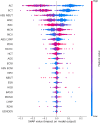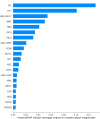Differential diagnosis of iron deficiency anemia from aplastic anemia using machine learning and explainable Artificial Intelligence utilizing blood attributes
- PMID: 39747241
- PMCID: PMC11695698
- DOI: 10.1038/s41598-024-84120-w
Differential diagnosis of iron deficiency anemia from aplastic anemia using machine learning and explainable Artificial Intelligence utilizing blood attributes
Abstract
As per world health organization, Anemia is a most prevalent blood disorder all over the world. Reduced number of Red Blood Cells or decrease in the number of healthy red blood cells is considered as Anemia. This condition also leads to the decrease in the oxygen carrying capacity of the blood. The main goal of this research is to develop a dependable method for diagnosing Aplastic Anemia and Iron Deficiency Anemia by examining the blood test attributes. As of today, there are no studies which use Interpretable Artificial Intelligence to perform the above differential diagnosis. The dataset used in this study is collected from Kasturba Medical College, Manipal. The dataset consisted of various blood test attributes such as Red Blood cell count, Hemoglobin level, Mean Corpuscular Volume, etc. One of the trending topics in Machine Learning is Explainable Artificial Intelligence. They are known to demystify the machine learning outputs to all its stakeholders. Hence, Five XAI tools including SHAP, LIME, Eli5, Qlattice and Anchor are used to understand the model's predictions. The importance characteristics according to XAI models are PLT, PCT, MCV, PDW, HGB, ABS LYMP, WBC, MCH, and MCHC. are employed to train and test the data. The goal of using data analytic techniques is to give medical professionals a useful tool that improves decision-making, enhances resource management, and eventually raises the standard of patient care. By considering the unique qualities of each patient, medical professionals who must rely on AI-assisted diagnosis and treatment suggestions, XAI offers arguments to strengthen their faith in the model outcomes.
Keywords: Aplastic Anemia; Classification; Ensemble models; Explainable Artificial Intelligence; Iron deficiency anemia; Machine learning.
© 2024. The Author(s).
Conflict of interest statement
Declarations. Competing interests: The authors declare no competing interests. Ethical approval: Ethical clearance has been obtained to collect patient data from Manipal Academy of Higher Education ethics committee with id IEC1 :229/2022. The need for informed consent was waived by ethics committee/ Institutional Review board of Manipal Academy of Higher Education, because of the retrospective nature of the study. All methods were carried out in accordance with relevant guidelines and regulations.
Figures















Similar articles
-
MultiThal-classifier, a machine learning-based multi-class model for thalassemia diagnosis and classification.Clin Chim Acta. 2025 Feb 1;567:120025. doi: 10.1016/j.cca.2024.120025. Epub 2024 Nov 7. Clin Chim Acta. 2025. PMID: 39521397
-
Detection of anemic condition in patients from clinical markers and explainable artificial intelligence.Technol Health Care. 2024;32(4):2431-2444. doi: 10.3233/THC-231207. Technol Health Care. 2024. PMID: 38339945
-
Empty iron stores in children and young adults--the diagnostic accuracy of MCV, MCH, and MCHC.Int J Lab Hematol. 2014 Feb;36(1):98-104. doi: 10.1111/ijlh.12132. Epub 2013 Aug 14. Int J Lab Hematol. 2014. PMID: 23941574
-
Explainability and white box in drug discovery.Chem Biol Drug Des. 2023 Jul;102(1):217-233. doi: 10.1111/cbdd.14262. Epub 2023 Apr 27. Chem Biol Drug Des. 2023. PMID: 37105727 Review.
-
Explainable artificial intelligence models using real-world electronic health record data: a systematic scoping review.J Am Med Inform Assoc. 2020 Jul 1;27(7):1173-1185. doi: 10.1093/jamia/ocaa053. J Am Med Inform Assoc. 2020. PMID: 32417928 Free PMC article.
References
-
- Vieth, J. T. & Lane, D. R. Anemia. Emerg. Med. Clin. 32 (3), 613–628. (2014). - PubMed
-
- World Health Organization. Worldwide prevalence of anaemia 1993–2005: WHO global database on anaemia. (2008).
-
- Milman, N. Anemia—still a major health problem in many parts of the world! Ann. Hematol.90, 369–377 (2011). - PubMed
-
- Salive, M. E. et al. Anemia and hemoglobin levels in older persons: Relationship with age, gender, and health status. J. Am. Geriatr. Soc.40 (5), 489–496 (1992). - PubMed
-
- Cappellini, M. D. & Motta, I. Anemia in clinical practice—definition and classification: Does hemoglobin change with aging?. Seminars Hematol. 52 (4), 261–269 (2015). - PubMed
Publication types
MeSH terms
LinkOut - more resources
Full Text Sources
Medical
Research Materials

